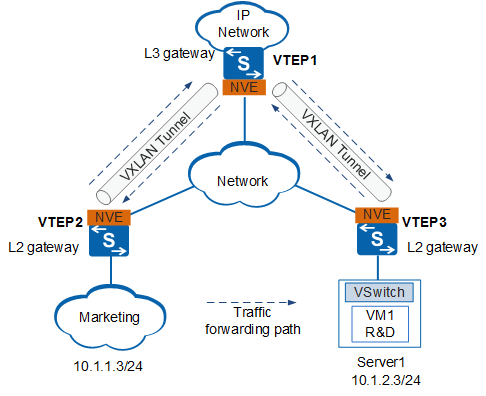Mutual Access Between the Virtual Network and Campus Networks
In Figure 1, VMs are deployed for the R&D department of the enterprise and a traditional network is deployed for the marketing department. There are mutual access requirements between the R&D personnel on the virtual network and marketing personnel on the campus network in their daily work.
In Figure 1, VTEP3 and VTEP2 are Layer 2 VXLAN gateways on the edge of the virtual network and traditional campus networks. VTEP1 serves as the Layer 3 VXLAN gateway, and it can establish VXLAN tunnels with VTEP2 and VTEP3 respectively to transmit VXLAN packets.
Packets from the marketing department to VM1 in the R&D department are processed in the following procedure:
- After receiving a packet from the traditional campus network, VTEP2 encapsulates the packet into a VXLAN packet and sends it to VTEP1.
- VTEP1 decapsulates the received VXLAN packet, removes the Ethernet header from the inner packet, parses the destination IP address, searches the routing table for the next hop based on the destination IP address, searches ARP entries based on the next hop, and determines the destination MAC address, VXLAN tunnel outbound interface, and VNI.
- VTEP1 re-encapsulates the VXLAN packet based on the obtained VXLAN tunnel outbound interface and VNI and sends it to VTEP3.
- VTEP3 finds the outbound interface based on the destination MAC address in the packet and sends the packet to the correct VM.
